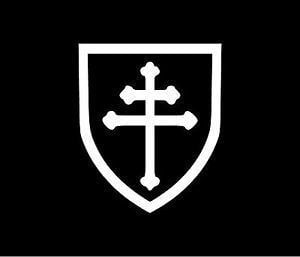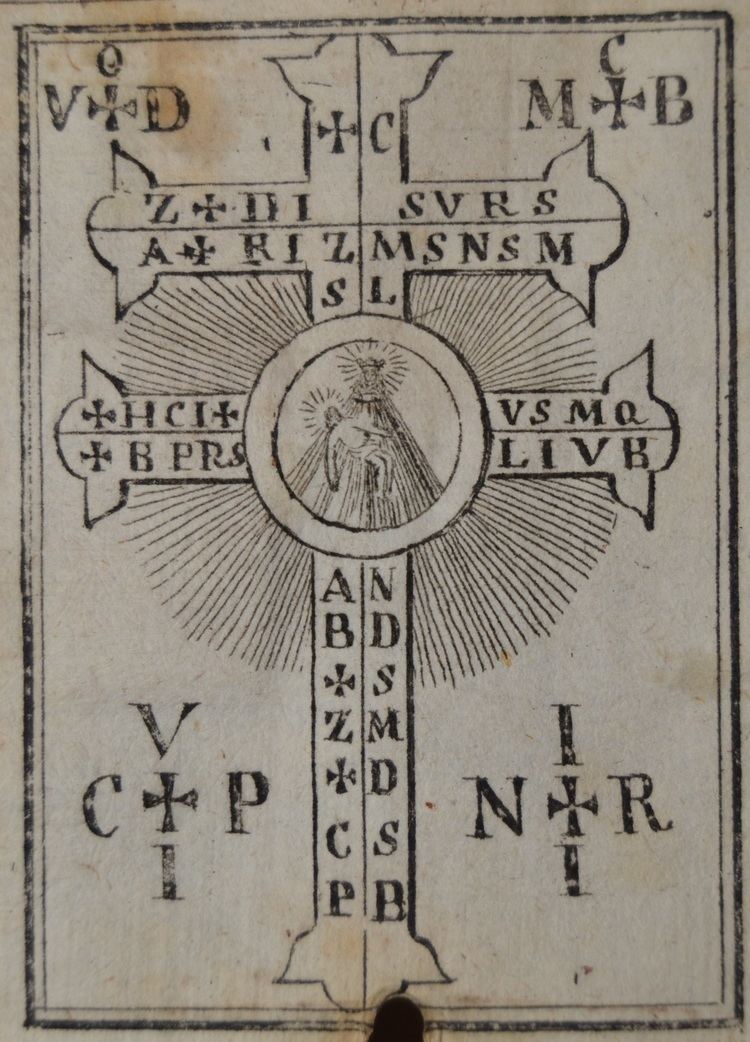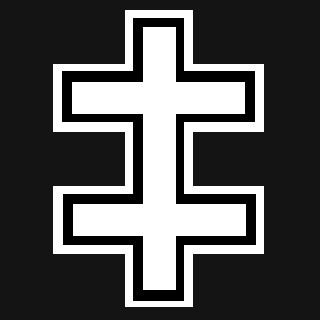 | ||
Gallows cross of lorraine official video
The Cross of Lorraine (French: Croix de Lorraine) was originally a heraldic cross. The two-barred cross consists of a vertical line crossed by two shorter horizontal bars. In most renditions, the horizontal bars are "graded" with the upper bar being the shorter, though variations with the bars of equal length are also seen. The Lorraine name has come to signify several cross variations, including the patriarchal cross with its bars near the top.
Contents
- Gallows cross of lorraine official video
- The mark of cain cross of lorraine lucifer s children
- Design
- History
- Symbol in France
- New World
- European heraldry
- Miscellaneous uses
- References

The mark of cain cross of lorraine lucifer s children
Design
The Cross of Lorraine consists of one vertical and two horizontal bars.
History

The Cross of Lorraine came from the Kingdom of Hungary to the Duchy of Lorraine. In Hungary, Béla III was the first monarch to use the two-barred cross as the symbol of royal power in the late 12th century. He probably adopted it from the Byzantine Empire, according to historian Pál Engel.

René II, Duke of Lorraine inherited the two-barred cross as a symbol from his ancestors from the House of Anjou. His grandfather, René the Good, who used it as his personal sigil, laid claim to four kingdoms, including Hungary. The cross was still known as the "cross of Anjou" in the 16th century. René II placed the symbol on his flag before the Battle of Nancy in January 1477. In the battle, René defeated the army of Charles the Bold, Duke of Burgundy, who had occupied the Duchy of Lorraine, and regained his duchy. All coins struck for René bore the symbol thereafter.
Symbol in France

The Cross of Lorraine is an emblem of Lorraine in eastern France. Between 1871 and 1918 (and again between 1940 and 1944), the north-eastern quarter of Lorraine was annexed to Germany, along with Alsace. During that period the Cross served as a rallying point for French ambitions to recover its lost provinces. This historical significance lent it considerable weight as a symbol of French patriotism. During World War II, Capitaine de corvette Thierry d'Argenlieu suggested the Cross of Lorraine as the symbol of the Free French Forces led by Charles de Gaulle as an answer to the Nazi swastika.

In France, the Cross of Lorraine was the symbol of Free France during World War II, the liberation of France from Nazi Germany, and Gaullism and includes several variations of a two barred cross.
The Cross was displayed on the flags of Free French warships, and the fuselages of Free French aircraft. The medal of the Order of Liberation bears the Cross of Lorraine.
De Gaulle himself is memorialised by a 43-metre (141 ft) high Cross of Lorraine in his home village of Colombey-les-Deux-Églises. The Cross of Lorraine was later adopted by Gaullist political groups such as the Rally for the Republic.
New World
French Jesuit missionaries and settlers to the New World carried the Cross of Lorraine c. 1750–1810. The symbol was said to have helped the missionaries to convert the native peoples they encountered, because the two-armed cross resembled existing local imagery.
European heraldry
The coat of arms of Hungary depicts a double cross, which is often attributed to Byzantine influence as King Béla III of Hungary was raised in the Byzantine Empire in the 12th century, and it was during his rule when the double cross became a symbol of Hungary. Also the 'dual cross' is the consonant 'gy' in ancient Hungarian runic writing which reads "egy" (one) when it stands alone mostly, if not always, with "God" meaning.
A golden double cross with equal bars, known as the Cross of Jagiellons, was used by Grand Duke of Lithuania and King of Poland Jogaila since his conversion to Christianity in 1386, as a personal insignia and was introduced in the Coat of Arms of Lithuania. Initially, the lower bar of the cross was longer than the upper, since it originates from the Hungarian type of the double cross. It later became the symbol of Jagiellon dynasty and is one of the national symbols of Lithuania, featured in the Order of the Cross of Vytis and the badge of the Lithuanian Air Force.
The double-barred cross is one of the national symbols in Belarus, both as the Jagiellon Cross and as the Cross of St. Euphrosyne of Polatsk, an important religious artifact. The symbol is supposed to have Byzantine roots and is used by the Belarusian Greek Catholic Church as a symbol uniting Eastern-Byzantine and Western-Latin church traditions. The Belarusian Cross can be found on the traditional coat of arms of Belarus, the Pahonia.
Miscellaneous uses
In Santo Daime, a syncretic religion from the Brazilian Amazon, this cross has a prominent place in the ritual, both as a physical symbol, and as referenced in numerous hymns sung during various services (see cross of caravaca).
The Scottish indie rock band Frightened Rabbit have used it as a symbol, notably on some merchandise and their album The Winter of Mixed Drinks, before switching to a three-barred papal cross for their EP State Hospital and their consecutive album Pedestrian Verse.
The cross is used as an emblem by the American Lung Association and related organizations through the world, and as such is familiar from their Christmas Seals program. Its use was suggested in 1902 by Paris physician Gilbert Sersiron as a symbol for the "crusade" against tuberculosis.
For its defense of France in World War I, the American 79th Infantry Division was nicknamed the "Cross of Lorraine" Division; its insignia is the cross. The German 79th Infantry Division of World War II used the cross of Lorraine as its insignia because its first attack was in the Lorraine region. The insignia was redesignated effective December 1, 2009, for the 79th US Army Reserve Sustainment Support Command in Los Alamitos, California.
In the television series Magnum, P.I., Thomas Magnum and his Vietnam War comrades were all shown to wear rings that bore the cross of Lorraine.
The cross is also used as the symbol of the fascist Norsefire party in the film version of the graphic novel V for Vendetta.
The cross of Lorraine was previously used in the SABRE, Apollo, and Worldspan global distribution systems (GDS) as a delimiter in various input formats, however, the latest version of the Graphical User Interface for each system uses a different symbol: Apollo displays it as a plus sign, Worldspan as a number sign, and Sabre as a yen symbol.
The "Cross of Lorraine" symbol appears in Unicode as U+2628 ☨ CROSS OF LORRAINE (HTML ☨). It is not to be confused with U+2021 ‡ double dagger (HTML ‡ · ‡).
The Cross of Lorraine was noted as a symbol of the Free French in the film Casablanca. A ring bearing the Cross was worn by Norwegian underground agent Berger and shown to one of the movies heroes (Victor Laszlo) as proof of loyalty.
It has also been used as a symbol for the city Roeselare (black cross) and Ypres (red cross) in Belgium.
282 (East Ham) Squadron, Air Training Corps have the "Cross of Lorraine" on their unit crest in honour of their previous Squadron President, Odette Hallowes who worked for an independent French section of the Special Operations Executive during World War II.
The Cross is also used as the symbol for the Celebritarian Corporation/art movement, created and led by musician/painter Marilyn Manson.
The Anglo-Canadian hardcore punk band Gallows use the cross as a symbol, as well as having named a song after it.
The Lorraine Cross is referenced in Sigma Phi Lambda Fraternity's brothers' song. The local fraternity was established in 1935 on the campus of LaSalle University, a Roman Catholic university run by the De LaSalle Christian Brothers located in Philadelphia, PA, USA. Sigma Phi Lambda recently celebrated its 80th Anniversary.
The Lorraine Cross also appears on Oreos.
